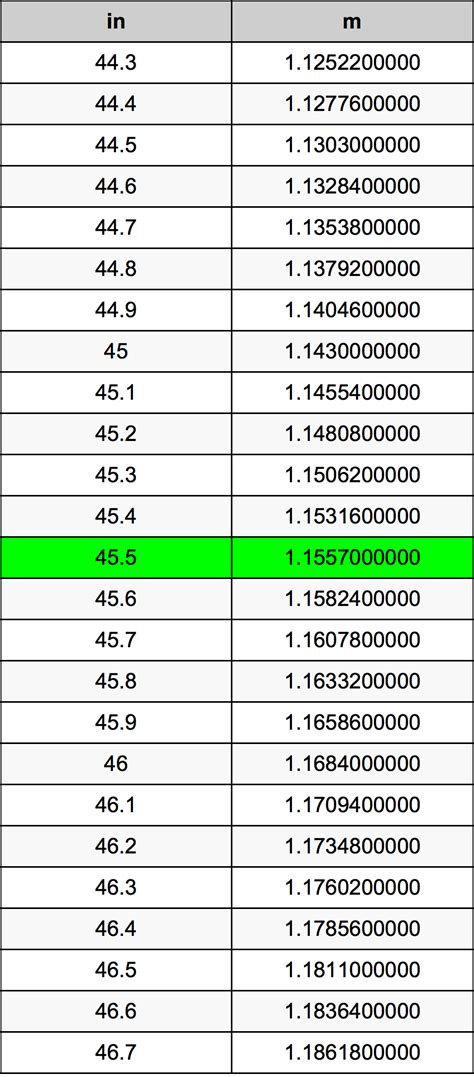Cuanto Es 45 Pulgadas En Metros
Kalali
Mar 28, 2025 · 4 min read

Table of Contents
How Many Meters is 45 Inches? A Comprehensive Guide to Unit Conversion
Knowing how to convert units of measurement is a crucial skill in many aspects of life, from everyday tasks to professional fields like engineering and design. This comprehensive guide will delve into the conversion of 45 inches to meters, providing a clear understanding of the process and offering additional insights into related unit conversions.
Understanding Units of Measurement:
Before we dive into the conversion, let's establish a foundational understanding of inches and meters.
-
Inches (in): An inch is a unit of length in the imperial and US customary systems of measurement. It's a relatively small unit, often used for measuring shorter lengths or distances.
-
Meters (m): A meter is the fundamental unit of length in the International System of Units (SI), a globally accepted system. It's significantly larger than an inch, commonly used for measuring larger distances and lengths.
The Conversion Process: 45 Inches to Meters
The key to converting inches to meters lies in understanding the conversion factor. There are approximately 39.37 inches in one meter. This means that one inch is equal to 0.0254 meters. To convert 45 inches to meters, we can use the following formula:
Meters = Inches × 0.0254
Plugging in the value of 45 inches, we get:
Meters = 45 inches × 0.0254 meters/inch ≈ 1.143 meters
Therefore, 45 inches is approximately 1.143 meters.
Understanding the Approximation:
It's important to note that the result is an approximation. The conversion factor 0.0254 is a rounded value. A more precise conversion would involve using a more precise value for the conversion factor, leading to a slightly different result. However, for most practical purposes, the approximation is sufficiently accurate.
Practical Applications of the Conversion:
The ability to convert inches to meters has numerous practical applications:
-
International Trade: Many global industries require consistent use of the metric system. Converting measurements ensures accurate communication and prevents misunderstandings.
-
Construction and Engineering: Accurate measurements are crucial in construction and engineering projects. Converting units ensures precision and prevents errors that could compromise safety and functionality.
-
Design and Manufacturing: Designers and manufacturers often work with both imperial and metric units. Converting units ensures compatibility and allows for seamless integration of different components.
-
Everyday Life: Even in everyday tasks, understanding unit conversions can be beneficial. For example, when purchasing items online from international sellers or comparing product specifications.
Beyond the Basic Conversion: Related Conversions
The conversion of 45 inches to meters can be a stepping stone to understanding more complex conversions. Here are some related conversions:
-
Inches to Centimeters: Since there are 100 centimeters in a meter, you can easily convert inches to centimeters by multiplying the number of inches by 2.54 (because 1 inch = 2.54 cm). 45 inches would therefore be 45 inches * 2.54 cm/inch = 114.3 centimeters.
-
Feet to Meters: Since there are 12 inches in a foot, you can first convert inches to feet and then feet to meters. Alternatively, you can use the direct conversion factor of approximately 0.3048 meters per foot.
-
Yards to Meters: Similar to feet, you can convert yards to meters using a conversion factor of approximately 0.9144 meters per yard.
-
Miles to Kilometers: For longer distances, the conversion from miles to kilometers is often needed. The conversion factor is approximately 1.609 kilometers per mile.
Tips for Accurate Unit Conversions:
-
Use a reliable conversion tool: Numerous online converters are available, offering quick and accurate conversions.
-
Double-check your calculations: Always double-check your work to ensure accuracy. Even a small error in the conversion can lead to significant discrepancies in the final result.
-
Understand the context: Pay attention to the context in which the conversion is needed. This will help you determine the appropriate level of precision required.
-
Round appropriately: When rounding your results, consider the level of precision needed. For some applications, a more precise result is necessary.
Conclusion:
Converting 45 inches to meters is a straightforward process, requiring only the application of a simple conversion factor. However, the underlying understanding of units and the ability to perform these conversions is crucial in a variety of contexts. By mastering this skill, you will enhance your ability to work effectively across different measurement systems and handle various tasks with precision and confidence. Remember, accurate conversions are not just about the numbers; they are about ensuring clarity, precision, and ultimately, success in your endeavors. This detailed guide provides a strong foundation for understanding and applying these essential unit conversion skills.
Latest Posts
Latest Posts
-
What Percent Is 80 Of 200
Apr 01, 2025
-
How Much Is 20 Of 80
Apr 01, 2025
-
Finding Zeros Of A Function Fraction
Apr 01, 2025
-
What Is The Lowest Common Multiple Of 4 And 7
Apr 01, 2025
-
How Many Feet Is 119 Inches
Apr 01, 2025
Related Post
Thank you for visiting our website which covers about Cuanto Es 45 Pulgadas En Metros . We hope the information provided has been useful to you. Feel free to contact us if you have any questions or need further assistance. See you next time and don't miss to bookmark.
